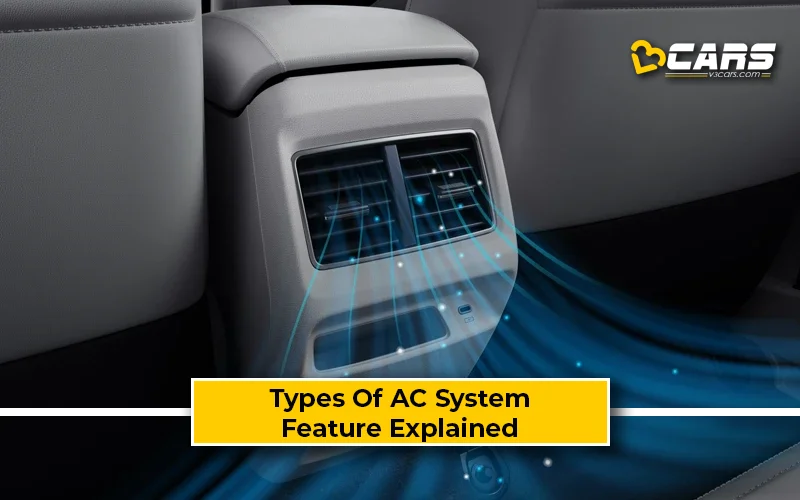Types Of AC Systems In Cars – Feature Explained
In India’s diverse climate, a car’s air conditioning system is not just a comfort feature; it’s a necessity. Over the years, automotive AC technology has evolved significantly, offering drivers and passengers varied levels of comfort and control. Understanding the different types of AC systems available can help you choose the ideal vehicle for your cooling needs.

What Are The Different Types Of AC Systems In Cars?
Car AC systems fundamentally work to cool the cabin by removing heat and humidity. However, they differ in how they allow the user to control the temperature, airflow, and other climate parameters. The 2 primary types found in cars today are:
- Manual Air Conditioning (AC)
- Automatic Climate Control (ACC)
How Do AC Systems Work?
All car air conditioning systems follow a basic refrigeration cycle, involving a compressor, condenser, expansion valve, and evaporator, to circulate refrigerant and produce cool air. The difference lies in the user interface and control logic.
1. Manual Air Conditioning (AC): This is the most basic form of car air conditioning. The driver manually adjusts various knobs and levers to control the cooling. While they offer basic cooling, they require frequent manual adjustments to maintain desired comfort as outside conditions change.
How It Works:
Temperature Knob: The driver turns a knob to mix hot air from the heater core with cool air from the evaporator, achieving a desired temperature.
Fan Speed Dial: The fan speed is manually set by the driver (settings like 1, 2, 3, 4).
Airflow Direction Control: Levers or buttons are used to manually direct airflow to the dashboard vents, footwells, or windshield.
AC On/Off Button: A button engages or disengages the compressor to start or stop the cooling process.
2. Automatic Climate Control (ACC): ACC automates the process of maintaining a set cabin temperature. Once the driver sets a desired temperature, the system takes over to achieve and maintain it.
How It Works: (As detailed in the previous "Automatic Climate Control - Feature Explained" article)
Temperature Sensors: Multiple sensors monitor cabin temperature, humidity, and even outside temperature.
Electronic Control Unit (ECU): The “brain” of the system receives data from sensors and the driver's desired temperature setting.
Actuators: The ECU then automatically controls the compressor, fan speed, airflow direction (via motorised flaps), and temperature blend door to precisely match the set temperature.
Types of Automatic Climate Control:
- Single-Zone ACC: The entire cabin is regulated to one desired temperature set by the driver.
- Dual-Zone ACC: Allows the driver and the front passenger to set and maintain independent temperatures for their respective sides of the cabin.
- Multi-Zone ACC: Extends independent temperature control to additional areas, such as rear passenger zones (tri-zone for driver, front passenger, and rear; quad-zone for driver, front passenger, and two separate rear zones).
What Are The Pros And Cons Of Each Type Of AC System?
Manual Air Conditioning (AC):
Here are the pros, or advantages, of manual air conditioning:
- Lower Cost: Much more affordable to manufacture and, consequently, to equip in a vehicle.
- Simpler Operation: Straightforward controls are easy for anyone to understand and use.
- Lower Repair Costs: Fewer complex electronic components mean potentially lower repair bills if issues arise.
Here are the cons, or disadvantages, of manual air conditioning:
- Requires Constant Adjustment: Needs frequent manual input to maintain a comfortable temperature as external conditions change.
- Less Precise: Offers less precise temperature control compared to ACC.
- Distraction: Fiddling with controls can be a minor distraction while driving.
Automatic Climate Control (ACC):
Here are the pros, or advantages, of automatic climate control:
- Effortless Comfort: Maintains a consistent cabin temperature automatically, eliminating manual adjustments.
- Improved Focus: Allows the driver to concentrate more on the road without climate control distractions.
- Faster Temperature Regulation: Reaches the desired temperature more quickly and efficiently.
- Reduced Humidity: Many systems include dehumidification functions to prevent window fogging.
- Personalisation (Multi-Zone): Dual-zone and multi-zone systems cater to individual temperature preferences for different occupants.
Here are the cons, or disadvantages, of automatic climate control:
- Higher Cost: ACC is usually found in higher, more expensive variants.
- More Complex System: Involves more sensors and electronic components, potentially leading to higher repair costs if major issues occur.
- Less Direct Control (Perception): Some drivers prefer the direct, hands-on control of a manual system.
Can AC Systems Be Fixed From The Aftermarket?
Individual components of any car AC system (like the compressor, condenser, or evaporator) can be repaired or replaced in the aftermarket. However, upgrading a manual AC system to a full automatic climate control system from the aftermarket is generally not feasible or advisable.
This is due to:
- Complexity: It involves integrating numerous sensors, an ECU, and motorised actuators that are deeply intertwined with the vehicle’s original wiring and software.
- High Cost: The parts and labour would be expensive, often exceeding the cost difference of buying a variant with ACC factory-fitted.
- Reliability Issues: Aftermarket integration of such complex systems can lead to reliability problems and affect other vehicle electronics.
Affordable Cars In India That Offer Each Type Of AC System?
Manual Air Conditioning (AC):
- Virtually all entry-level cars in India offer manual AC as standard. This includes models like the Maruti Suzuki Alto K10, Renault Kwid, Maruti Suzuki S-Presso, and base variants of larger hatchbacks, SUVs and sedans.
Automatic Climate Control (Single-Zone):
- This feature is increasingly common in mid-range to higher variants of affordable cars in India such as the Hyundai Grand i10 Nios, Tata Tiago, Maruti Suzuki Swift, Maruti Suzuki Baleno, Hyundai Aura, Honda Amaze, Tata Punch, Maruti Suzuki Brezza, Hyundai Venue, Kia Sonet , Renault Kiger, etc.
Dual-Zone Automatic Climate Control:
- This is typically found in higher variants of C-segment SUVs and sedans, and occasionally in top trims of B2-SUVs such as the Mahindra XUV 3XO.
Multi-Zone Automatic Climate Control:
- This feature is generally reserved for premium and larger SUVs or MPVs in India such as the Kia Carens Clavis, Innova Hycross, Mahindra XUV700 and Toyota Fortuner.
Also Read:
Helpful Tools:
- Fuel Cost Calculator for Cars – Know your monthly fuel expense based on usage and mileage
- Car On-Road Price Calculator – Convert ex-showroom to on-road price for any city
Sell Used Car Online – Enter your car and contact details to get an instant price estimate and book a free inspection with our partner network


0 Comments